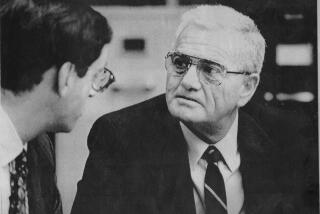Michelle McNamara’s terrific, obsessive ‘I’ll Be Gone in the Dark’

It was August 1980, in Orange County. A man looking for his son and daughter-in-law walked into their house, “decorated in late-seventies style. Sword fish on the wall. Tiffany chandelier. Ropy plant hangers.” The young couple was nowhere to be seen. The man went into the bedroom, pulled back the comforter, and found them. Patty and Keith Harrington lay broken, face down in a swath of blood. There is something particularly captivating about an unsolved murder. “If you commit murder and then vanish,” Michelle McNamara writes, “what you leave behind isn’t just pain but absence, a supreme blankness that triumphs over everything else. The unidentified murderer is always twisting a doorknob behind a door that never opens.”
The Golden State Killer, a name McNamara bestowed on the criminal responsible for at least 50 sexual assaults and 10 deaths, began as a rapist, entering homes and assaulting women — sometimes as their husbands lay bound nearby, a stack of plates placed on their backs as a crude alarm system — on the east side of Sacramento in 1976. He cased neighborhoods, houses and potential victims carefully. Some theorized he attended open houses, as many of the crimes took place at or near properties for sale. He wore a ski mask, but victims remembered his voice, his labored breathing, his unsettling sobs after some of the rapes. Back when he was known as the “East Area Rapist,” McNamara writes, he “was the bogeyman in the bedroom, the stranger who knew too much — layouts of homes, number of children, work schedules.” By the mid-’80s, he turned south — to Ventura, Irvine, Santa Barbara — and to killing.
His victims left behind half-completed projects, interrupted progress on their careers, family relationships and the inevitable work of a life’s journey. So did McNamara, who died at age 46 (due to an undiagnosed heart condition, combined with an accidental mix of medications), leaving not only a husband — Patton Oswalt — and their young daughter, but also a book in progress. It centered on these cold cases, the criminal justice version of unfinished business. For several years before her death, McNamara had worked on solving a crime. She wasn’t a detective or a criminologist, just a writer whose intense curiosity about an unsolved series of rapes and killings bloomed into a kind of obsession.
In “I’ll Be Gone in the Dark,” the book she was working on when she died, McNamara was smart enough to recognize her own obsession and make it part of the story she tells. At its center is the criminal who terrified Californians in the 1970s and ’80s. His identity is still a mystery, but the book is much more than a whodunit; McNamara’s point of view expands to include his victims, their loved ones, the police who tried to catch him, the amateur sleuths who gather online to share clues and the communities in which he plied his violent trade.
“I’ve always thought the least appreciated aspect of a great true crime writer is humanity,” Gillian Flynn points out in the book’s introduction. What makes McNamara’s work so compelling is her empathy and sensitivity toward the people touched by these crimes. As the “Gone Girl” author continues, McNamara excels at capturing “the people — hopeful ex-hippies, striving newlyweds, a mother and her teen daughter arguing over freedom and responsibility and swimsuits for what they didn’t realize would be the last time.” It’s a strength McNamara’s widower, comedian Oswalt, also notes in the book’s afterword: “What interested her, what sparked her mind and torqued every neuron and receptor, were people.”
Because the people raped, killed and terrorized by the Golden State Killer were Californians during the Carter and Reagan administrations, there’s something nostalgic in reading about their lives. These were the years between the end of Vietnam and the beginning of the first Gulf War. MTV was born during this era, but the Internet hadn’t yet grabbed our eyeballs. McNamara had a great eye for finding, even in the dry-as-dirt police documents, little grace notes. “The neighbors, in the scant five or six lines allotted to them in the canvass reports, offer evocative haikus of a certain time and place,” she writes. “When questioned, they’re on their way back from the disco club, or a double feature of ‘Earthquake’ and ‘Airport ‘77’ at the drive-in, or the Jack LaLanne gym.”
McNamara didn’t begin learning about the Golden State Killer until 2007, three decades after his last known killing, but she was already obsessed with crime, indelibly marked by an unsolved homicide in her neighborhood when she was an adolescent. “Violent men unknown to me have occupied my mind all my adult life,” McNamara writes. “The part of the brain reserved for sports statistics or dessert recipes or Shakespeare quotes is, for me, a gallery of harrowing aftermaths: a boy’s BMX bike, its wheels still spinning, abandoned in a ditch along a country road; a tuft of microscopic green fibers collected from the small of a dead girl’s back.” Before long, she writes, “I was a hoarder of ominous and puzzling details. I developed a Pavlovian response to the word ‘mystery.’”
“There’s a scream permanently lodged in my throat now,” McNamara writes. Years of hunting the killer, talking to victims, thinking about the crimes, had an effect. She recounts a series of thoughtful anniversary gifts from Oswalt, all GSK-themed, and the year she forgot to even give him a card. Like any addiction, there’s thrill and danger, intertwined. “What I always think about,” McNamara writes, “are experiments that show that animals in captivity would rather have to search for their food than have it given to them. Seeking is the lever that tips our dopamine gush. What I don’t mention is the uneasy realization I’ve had about how much our frenetic searching mirrors the compulsive behavior — the trampled flowerbeds, scratch marks on window screens, crank calls — of the one we seek.”
Because McNamara died before completing the book, the published version is a bit of a group effort. In addition to Flynn’s introduction and the afterword by Patton, the text includes finished chapters alongside sections of material stitched together from notes or repurposed from earlier magazine articles McNamara wrote. The book’s final chapter is a behind-the-scenes look at some of the data-driven sleuthing McNamara was pursuing, which is still ongoing. The prose here can’t match McNamara’s (I wish I could read the next 10 books she would have written), but the authors raise interesting points and provide a glimpse into the camaraderie that McNamara found so appealing on the message boards. After all, as McNamara noted in an email to her editor, “inside everyone lurks a Sherlock Holmes that believes that given the right amount of clues they could solve a mystery.”
The book ends, fittingly, with an epilogue in which McNamara addresses the Golden State Killer directly. “The tables have been turned,” she warns him in this fantasy of justice at long last delivered. “A ski mask won’t help you now.”
Tuttle is the president of the National Book Critics Circle.
Patton Oswalt will appear at 12:30 p.m. April 22 at the L.A. Times Festival of Books to discuss “I’ll Be Gone in the Dark” and more at Bovard Auditorium with Times books editor Carolyn Kellogg.
::
“I’ll Be Gone in the Dark: One Woman’s Obsessive Search for the Golden State Killer”
Michelle McNamara
Harper: 352 pp., $27.99
More to Read
Sign up for our Book Club newsletter
Get the latest news, events and more from the Los Angeles Times Book Club, and help us get L.A. reading and talking.
You may occasionally receive promotional content from the Los Angeles Times.










